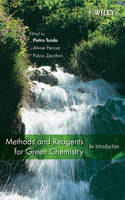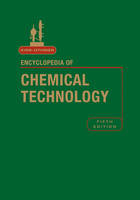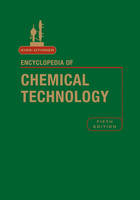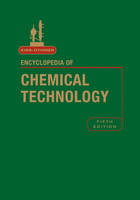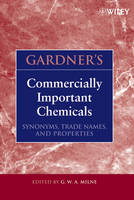Process Analytical Technology
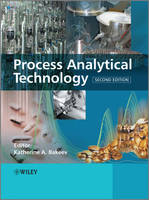 portes grátis
portes grátis
Process Analytical Technology
Spectroscopic Tools and Implementation Strategies for the Chemical and Pharmaceutical Industries
Bakeev, Katherine A.
John Wiley & Sons Inc
04/2010
592
Dura
Inglês
9780470722077
15 a 20 dias
1214
List of Contributors xix
List of Abbreviations xxi
1 Overview of Process Analysis and PAT 1
Jason E. Dickens
1.1 Introduction 1
1.1.1 Historical perspective 3
1.1.2 Business drivers 4
1.2 Execution of Process Analysis Projects 5
1.2.1 Wisdoms 5
1.2.2 Team structure 6
1.2.3 Project life cycle 6
1.2.4 Project scoping 9
1.2.5 Common challenges and pitfalls 10
1.3 Process Instrumentation 12
1.3.1 Process instrumentation types 12
1.3.2 Novel process instrumentation 12
1.4 Conclusions 13
1.5 Glossary of Acronyms and Terms 14
References 14
2 Implementation of Process Analytical Technologies 17
Robert Guenard and Gert Thurau
2.1 Introduction to Implementation of Process Analytical Technologies (PAT) in the Industrial Setting 17
2.1.1 Definition of process analytics 18
2.1.2 Differences between process analyzers and laboratory analysis 19
2.1.3 General industrial drivers for PA 19
2.1.4 Types of applications (R&D versus manufacturing) 20
2.1.5 Organizational considerations 20
2.2 Generalized Process Analytics Work Process 23
2.2.1 Project identification and definition 24
2.2.2 Analytical application development 26
2.2.3 Design, specify and procure 26
2.2.4 Implementation in production 28
2.2.5 Routine operation 29
2.2.6 Continuous improvement 30
2.3 Considerations for PAT Implementation in the Pharmaceutical Industry 30
2.3.1 Introduction 30
2.3.2 Business model 30
2.3.3 Technical differences 31
2.3.4 Regulatory Aspects of Process Analytics in the Pharmaceutical Industry -the Concept of Quality by Design 33
2.4 Conclusions 36
References 36
3 Process Sampling: Theory of Sampling - the Missing Link in Process Analytical Technologies (PAT) 37
Kim H. Esbensen and Peter Paasch-Mortensen
3.1 Introduction 37
3.2 Theory of Sampling - Introduction 39
3.2.1 Heterogeneity 41
3.2.2 Constitutional heterogeneity 41
3.2.3 Distributional heterogeneity 42
3.2.4 Structurally correct sampling 45
3.2.5 Incorrect sampling error 45
3.2.6 Increment delimitation error 45
3.2.7 Increment extraction error 46
3.2.8 Increment preparation error 46
3.2.9 Increment weighing error 47
3.2.10 Total sampling error 48
3.2.11 Global estimation error 48
3.3 Mass Reduction as a Specific Sampling Procedure 48
3.4 Fundamental Sampling Principle 51
3.5 Sampling - a Very Practical Issue 51
3.5.1 Sampling unit operations 52
3.5.2 Understanding process sampling: 0-D versus 1-D LOTS 52
3.5.3 Grab sampling - 0-D and 1-D 54
3.5.4 Correct process sampling: increment delimitation/extraction 56
3.5.5 PAT versus correct process sampling - what is required? 58
3.6 Reactors and Vessels - Identical Process Sampling Issues 60
3.6.1 Correct process sampling with existing process technology 62
3.6.2 Upward flux - representative colocated PAT sampling 62
3.6.3 Upstream colocated PAT sampler 64
3.7 Heterogeneity Characterization of 1-D lots: Variography 66
3.7.1 Process sampling modes 67
3.7.2 The experimental variogram 67
3.7.3 Sampling plan simulation and estimation of TSE 71
3.7.4 TSE estimation for 0-D lots - batch sampling 72
3.7.5 Corporate QC benefits of variographic analysis 73
3.8 Data Quality - New Insight from the TOS 75
3.9 Validation in Chemometrics and PAT 76
3.10 Summary 78
References 79
4 UV-visible Spectroscopy for On-line Analysis 81
Marcel A. Liauw, Lewis C. Baylor and Patrick E. O'Rourke
4.1 Introduction 81
4.2 Theory 82
4.2.1 Chemical concentration 82
4.2.2 Color 84
4.2.3 Film thickness 85
4.2.4 Turbidity 85
4.2.5 Plasmons/nanoparticles 85
4.3 Instrumentation 85
4.4 Sample Interface 86
4.4.1 Cuvette/vial 87
4.4.2 Flow cells 87
4.4.3 Insertion probe 87
4.4.4 Reflectance probe 89
4.5 Implementation 89
4.5.1 A complete process analyzer 89
4.5.2 Troubleshooting 89
4.6 Applications 91
4.6.1 Gas and vapor analysis 92
4.6.2 Liquid analysis 92
4.6.3 Solid analysis 96
4.6.4 Other applications 99
4.7 Detailed Application Notes 100
4.7.1 Gas and vapor analysis: toluene 100
4.7.2 Liquid analysis: breakthrough curves 101
4.7.3 Solids analysis: extruded plastic color 101
4.7.4 Film thickness determination: polymer 103
4.8 Conclusion 104
References 104
5 Near-infrared Spectroscopy for Process Analytical Technology: Theory, Technology and Implementation 107
Michael B. Simpson
5.1 Introduction 107
5.2 Theory of Near-infrared Spectroscopy 112
5.3 Analyser Technologies in the Near-infrared 114
5.3.1 Light sources and detectors for near-infrared analyzers 114
5.3.2 The scanning grating monochromator and polychromator diode-array 119
5.3.3 The acousto-optic tunable filter (AOTF) analyzer 123
5.3.4 Fourier transform near-infrared analyzers 127
5.3.5 Emerging technologies in process NIR analyzers 134
5.4 The Sampling Interface 136
5.4.1 Introduction 136
5.4.2 Problem samples: liquids, slurries and solids 142
5.4.3 The use of fiber optics 145
5.5 Practical Examples of Near-infrared Analytical Applications 147
5.5.1 Refinery hydrocarbon streams 148
5.5.2 Polyols, ethoxylated derivatives, ethylene oxide/propylene oxide polyether polyols 149
5.5.3 Oleochemicals, fatty acids, fatty amines and biodiesel 151
5.6 Conclusion 152
References 153
6 Infrared Spectroscopy for Process Analytical Applications 157
John P. Coates
6.1 Introduction 157
6.2 Practical Aspects of IR Spectroscopy 161
6.3 Instrumentation Design and Technology 163
6.4 Process IR Instrumentation 166
6.4.1 Commercially available IR instruments 167
6.4.2 Important IR component technologies 172
6.4.3 New technologies for IR components and instruments 176
6.4.4 Requirements for process infrared analyzers 178
6.4.5 Sample handling for IR process analyzers 185
6.4.6 Issues for consideration in the implementation of process IR 187
6.5 Applications of Process IR Analyzers 189
6.6 Process IR Analyzers: a Review 191
6.7 Trends and Directions 192
References 193
7 Raman Spectroscopy 195
Nancy L. Jestel
7.1 Attractive Features of Raman Spectroscopy 195
7.1.1 Quantitative information 195
7.1.2 Flexible sample forms and sizes used as accessed without damage 196
7.1.3 Flexible sample interfaces 196
7.1.4 Attractive spectral properties and advantageous selection rules 197
7.1.5 High sampling rate 197
7.1.6 Stable and robust equipment 198
7.2 Potential Issues with Raman Spectroscopy 198
7.2.1 High background signals 198
7.2.2 Stability 198
7.2.3 Too much and still too little sensitivity 199
7.2.4 Personnel experience 199
7.2.5 Cost 200
7.3 Fundamentals of Raman Spectroscopy 200
7.4 Raman Instrumentation 203
7.4.1 Safety 203
7.4.2 Laser wavelength selection 204
7.4.3 Laser power and stability 204
7.4.4 Spectrometer 205
7.4.5 Sample interface (probes) 206
7.4.6 Communications 208
7.4.7 Maintenance 209
7.5 Quantitative Raman 209
7.6 Applications 212
7.6.1 Acylation, alkylation, catalytic cracking, and transesterification 213
7.6.2 Bioreactors 213
7.6.3 Blending 214
7.6.4 Calcination 214
7.6.5 Catalysis 215
7.6.6 Chlorination 216
7.6.7 Counterfeit pharmaceuticals 217
7.6.8 Extrusion 218
7.6.9 Forensics 218
7.6.10 Hydrogenation 218
7.6.11 Hydrolysis 219
7.6.12 Medical diagnostics 219
7.6.13 Microwave-assisted organic synthesis 219
7.6.14 Mobile or field uses 220
7.6.15 Natural products 220
7.6.16 Orientation, stress, or strain 221
7.6.17 Ozonolysis 222
7.6.18 Polymerization 222
7.6.19 Polymer curing 224
7.6.20 Polymorphs (crystal forms) 225
7.6.21 Product properties 228
7.6.22 Purification: distillation, filtration, drying 229
7.6.23 Thin films or coatings 229
7.7 Current State of Process Raman Spectroscopy 230
References 231
8 Near-infrared Chemical Imaging for Product and Process Understanding 245
E. Neil Lewis, Joseph W. Schoppelrei, Lisa Makein, Linda H. Kidder and Eunah Lee
8.1 The PAT Initiative 245
8.2 The Role of Near-infrared Chemical Imaging (NIR-CI) in the Pharmaceutical Industry 246
8.2.1 Characterization of solid dosage forms 246
8.2.2 'A picture is worth a thousand words' 247
8.3 Evolution of NIR Imaging Instrumentation 247
8.3.1 Spatially resolved spectroscopy - mapping 247
8.3.2 The infrared focal-plane array 247
8.3.3 Wavelength selection 248
8.3.4 The benefits of NIR spectroscopy 248
8.3.5 NIR imaging instrumentation 249
8.4 Chemical Imaging Principles 251
8.4.1 The hypercube 251
8.4.2 Data analysis 251
8.4.3 Spectral correction 252
8.4.4 Spectral preprocessing 253
8.4.5 Classification 253
8.4.6 Image processing - statistical 255
8.4.7 Image processing - morphology 257
8.5 PAT Applications 257
8.5.1 Content uniformity measurements - 'self calibrating' 258
8.5.2 Quality assurance - imaging an intact blister pack 260
8.5.3 Contaminant detection 261
8.5.4 Imaging of coatings - advanced design delivery systems 263
8.6 Processing Case Study: Estimating 'Abundance' of Sample Components 267
8.6.1 Experimental 268
8.6.2 Spectral correction and preprocessing 268
8.6.3 Analysis 268
8.6.4 Conclusions 273
8.7 Processing Case Study: Determining Blend Homogeneity Through Statistical Analysis 273
8.7.1 Experimental 273
8.7.2 Observing visual contrast in the image 274
8.7.3 Statistical analysis of the image 274
8.7.4 Blend uniformity measurement 276
8.7.5 Conclusions 276
8.8 Final Thoughts 277
Acknowledgements 278
References 278
9 Acoustic Chemometric Monitoring of Industrial Production Processes 281
Maths Halstensen and Kim H. Esbensen
9.1 What is Acoustic Chemometrics? 281
9.2 How Acoustic Chemometrics Works 282
9.2.1 Acoustic sensors 282
9.2.2 Mounting acoustic sensors (accelerometers) 283
9.2.3 Signal processing 284
9.2.4 Chemometric data analysis 284
9.2.5 Acoustic chemometrics as a PAT tool 284
9.3 Industrial Production Process Monitoring 285
9.3.1 Fluidized bed granulation monitoring 285
9.3.2 Pilot scale studies 286
9.3.3 Monitoring of a start-up sequence of a continuous fluidized bed granulator 291
9.3.4 Process monitoring as an early warning of critical shutdown situations 295
9.3.5 Acoustic chemometrics for fluid flow quantification 296
9.4 Available On-line Acoustic Chemometric Equipment 299
9.5 Discussion 301
9.5.1 Granulator monitoring 301
9.5.2 Process state monitoring 301
9.5.3 Ammonia concentration monitoring 301
9.6 Conclusions 302
References 302
10 Process NMR Spectroscopy: Technology and On-line Applications 303
John C. Edwards and Paul J. Giammatteo
10.1 Introduction 303
10.2 NMR Spectroscopy Overview 305
10.2.1 The NMR phenomenon 305
10.2.2 Time-domain-NMR: utilization of the FID and spin relaxation 309
10.2.3 High-resolution NMR: obtaining a spectrum with resolved chemical shift information 312
10.3 Process NMR Instrumentation 313
10.3.1 Spectrometer and magnet design 313
10.3.2 Sampling and experimental design 316
10.4 Postprocessing Methodologies for NMR Data 317
10.5 Advantages and Limitations of NMR as a Process Analytical Technology 320
10.5.1 Advantages 320
10.5.2 Limitations 321
10.6 On-line and At-line Applications 321
10.6.1 Time-domain NMR 322
10.6.2 High-resolution NMR: chemometric applications 323
10.7 Current Development and Applications 330
10.8 Conclusions 331
References 332
11 Fluorescent Sensing and Process Analytical Applications 337
Jason E. Dickens
11.1 Introduction 337
11.2 Luminescence Fundamentals 338
11.2.1 Luminescence nomenclature 338
11.2.2 Luminescence processes 338
11.2.3 Fluorophore classification 338
11.3 LIF Sensing Fundamentals 341
11.3.1 LIF sensing classification 341
11.3.2 Luminescence spectroscopy 342
11.3.3 LIF signal response function 343
11.4 LIF Sensing Instrumentation 343
11.4.1 LIF photometric instrument specification 345
11.4.2 LIF Instrument selection 347
11.5 Luminescent Detection Risks 347
11.6 Process Analytical Technology Applications 348
11.6.1 Petrochemical, chemical and nuclear field applications 349
11.6.2 Pharmaceutical PAT applications 349
11.7 Conclusions 350
References 351
12 Chemometrics in Process Analytical Technology (PAT) 353
Charles E. Miller
12.1 Introduction 353
12.1.1 What is chemometrics? 353
12.1.2 Some history 354
12.1.3 Some philosophy 355
12.1.4 Chemometrics in analytical chemistry? 355
12.1.5 Chemometrics in process analytical chemistry? 356
12.2 Foundations of Chemometrics 356
12.2.1 Notation 356
12.2.2 Some basic statistics 358
12.2.3 Linear regression 359
12.2.4 Multiple linear regression 361
12.2.5 Principal components analysis (PCA) 362
12.2.6 Design of experiments (DOE) 366
12.3 Chemometric Methods in PAT 368
12.3.1 Data preprocessing 369
12.3.2 Quantitative model building 377
12.3.3 Qualitative model building 389
12.3.4 Exploratory analysis 397
12.4 Overfitting and Model Validation 407
12.4.1 Overfitting and underfitting 407
12.4.2 Test set validation 408
12.4.3 Cross validation 410
12.5 Outliers 413
12.5.1 Introduction to outliers 413
12.5.2 Outlier detection and remediation 413
12.6 Calibration Strategies in PAT 416
12.6.1 The 'calibration strategy space' 417
12.6.2 Strategies for direct versus inverse modeling methods 418
12.6.3 Hybrid strategies 419
12.7 Sample and Variable Selection in Chemometrics 420
12.7.1 Sample selection 420
12.7.2 Variable selection 421
12.8 Troubleshooting/Improving an Existing Method 425
12.8.1 Method assessment 425
12.8.2 Model improvement strategies 425
12.9 Calibration Transfer and Instrument Standardization 426
12.9.1 Slope/intercept adjustment 428
12.9.2 Piecewise direct standardization (PDS) 428
12.9.3 Generalized least squares (GLS) weighting 429
12.9.4 Shenk-Westerhaus method 429
12.9.5 Other transfer/standardization methods 429
12.10 Chemometric Model Deployment Issues in PAT 430
12.10.1 Outliers in prediction 430
12.10.2 Deployment software 432
12.10.3 Data systems, and control system integration 432
12.10.4 Method updating 433
12.11 People Issues 433
12.12 The Final Word 434
References 434
13 On-line PAT Applications of Spectroscopy in the Pharmaceutical Industry 439
Brandye Smith-Goettler
13.1 Background 439
13.2 Reaction Monitoring 441
13.3 Crystallization 442
13.4 API Drying 443
13.5 Nanomilling 444
13.6 Hot-melt Extrusion 445
13.7 Granulation 446
13.7.1 Wet granulation 446
13.7.2 Roller compaction 449
13.8 Powder Blending 450
13.8.1 Lubrication 451
13.8.2 Powder flow 451
13.9 Compression 452
13.10 Coating 452
13.11 Biologics 453
13.11.1 Fermentation 453
13.11.2 Freeze-drying 454
13.12 Cleaning Validation 454
13.13 Conclusions 455
References 455
14 NIR spectroscopy in Pharmaceutical Analysis: Off-line and At-line PAT Applications 463
Marcelo Blanco Romia and Manel Alcala Bernardez
14.1 Introduction 463
14.1.1 Operational procedures 464
14.1.2 Instrument qualification 466
14.2 Foundation of Qualitative Method Development 466
14.2.1 Pattern recognition methods 467
14.2.2 Construction of spectral libraries 468
14.2.3 Identification and qualification 470
14.3 Foundation of Quantitative Method Development 471
14.3.1 Selection and preparation of samples 472
14.3.2 Preparation and selection of samples 473
14.3.3 Determination of reference values 474
14.3.4 Acquisition of spectra 474
14.3.5 Construction of the calibration model 475
14.3.6 Model validation 476
14.3.7 Prediction of new samples 476
14.4 Method Validation 476
14.5 Calibration Transfer 476
14.6 Pharmaceutical Applications 478
14.6.1 Identification of raw materials 478
14.6.2 Homogeneity 478
14.6.3 Moisture 480
14.6.4 Determination of physical parameters 481
14.6.5 Determination of chemical composition 483
14.7 Conclusions 485
References 486
15 Near-infrared Spectroscopy (NIR) as a PAT Tool in the Chemical Industry: Added Value and Implementation Challenges 493
Ann M. Brearley and Susan J. Foulk
15.1 Introduction 493
15.2 Successful Process Analyzer Implementation 494
15.2.1 A process for successful process analyzer implementation 494
15.2.2 How NIR process analyzers contribute to business value 497
15.2.3 Issues to consider in setting technical requirements for a process analyzer 498
15.2.4 Capabilities and limitations of NIR 499
15.2.5 General challenges in process analyzer implementation 500
15.2.6 Approaches to calibrating an NIR analyzer on-line 502
15.2.7 Special challenges in NIR monitoring of polymer melts 505
15.3 Example Applications 506
15.3.1 Monitoring monomer conversion during emulsion polymerization 506
15.3.2 Monitoring a diethylbenzene isomer separation process 508
15.3.3 Monitoring the composition of copolymers and polymer blends in an extruder 509
15.3.4 Rapid identification of carpet face fiber 512
15.3.5 Monitoring the composition of spinning solution 514
15.3.6 Monitoring end groups and viscosity in polyester melts 516
15.3.7 In-line monitoring of a copolymerization reaction 518
References 520
16 Future Trends for PAT for Increased Process Understanding and Growing Applications in Biomanufacturing 521
Katherine A. Bakeev and Jose C. Menezes
16.1 Introduction 521
16.2 Regulatory Guidance and its Impact on PAT 522
16.3 Going Beyond Process Analyzers Towards Solutions 524
16.3.1 Design of experiments for risk-based analysis 526
16.3.2 Sample and process fingerprinting with PAT tools 527
16.3.3 Design and Control Spaces 528
16.3.4 Chemometrics and process analysis 528
16.4 Emerging Application Areas of PAT 529
16.4.1 Biofuels 529
16.4.2 Biomanufacturing 530
16.5 New and Emerging Sensor and Control Technologies 531
16.5.1 Terahertz spectroscopy 531
16.5.2 Integrated sensing and processing 532
16.5.3 Dielectric spectroscopy 533
16.5.4 Process chromatography 533
16.5.5 Mass spectrometry 534
16.5.6 Microwave resonance 534
16.5.7 Novel sensors 535
16.5.8 Inferential sensors 536
16.6 Advances in Sampling: NeSSI 537
16.7 Challenges Ahead 537
16.7.1 Continuous process validation 538
16.7.2 Data challenges: data handling and fusion 539
16.7.3 Regulatory challenges 539
16.7.4 Enterprise systems for managing data 539
16.8 Conclusion 540
References 540
Index 545
List of Contributors xix
List of Abbreviations xxi
1 Overview of Process Analysis and PAT 1
Jason E. Dickens
1.1 Introduction 1
1.1.1 Historical perspective 3
1.1.2 Business drivers 4
1.2 Execution of Process Analysis Projects 5
1.2.1 Wisdoms 5
1.2.2 Team structure 6
1.2.3 Project life cycle 6
1.2.4 Project scoping 9
1.2.5 Common challenges and pitfalls 10
1.3 Process Instrumentation 12
1.3.1 Process instrumentation types 12
1.3.2 Novel process instrumentation 12
1.4 Conclusions 13
1.5 Glossary of Acronyms and Terms 14
References 14
2 Implementation of Process Analytical Technologies 17
Robert Guenard and Gert Thurau
2.1 Introduction to Implementation of Process Analytical Technologies (PAT) in the Industrial Setting 17
2.1.1 Definition of process analytics 18
2.1.2 Differences between process analyzers and laboratory analysis 19
2.1.3 General industrial drivers for PA 19
2.1.4 Types of applications (R&D versus manufacturing) 20
2.1.5 Organizational considerations 20
2.2 Generalized Process Analytics Work Process 23
2.2.1 Project identification and definition 24
2.2.2 Analytical application development 26
2.2.3 Design, specify and procure 26
2.2.4 Implementation in production 28
2.2.5 Routine operation 29
2.2.6 Continuous improvement 30
2.3 Considerations for PAT Implementation in the Pharmaceutical Industry 30
2.3.1 Introduction 30
2.3.2 Business model 30
2.3.3 Technical differences 31
2.3.4 Regulatory Aspects of Process Analytics in the Pharmaceutical Industry -the Concept of Quality by Design 33
2.4 Conclusions 36
References 36
3 Process Sampling: Theory of Sampling - the Missing Link in Process Analytical Technologies (PAT) 37
Kim H. Esbensen and Peter Paasch-Mortensen
3.1 Introduction 37
3.2 Theory of Sampling - Introduction 39
3.2.1 Heterogeneity 41
3.2.2 Constitutional heterogeneity 41
3.2.3 Distributional heterogeneity 42
3.2.4 Structurally correct sampling 45
3.2.5 Incorrect sampling error 45
3.2.6 Increment delimitation error 45
3.2.7 Increment extraction error 46
3.2.8 Increment preparation error 46
3.2.9 Increment weighing error 47
3.2.10 Total sampling error 48
3.2.11 Global estimation error 48
3.3 Mass Reduction as a Specific Sampling Procedure 48
3.4 Fundamental Sampling Principle 51
3.5 Sampling - a Very Practical Issue 51
3.5.1 Sampling unit operations 52
3.5.2 Understanding process sampling: 0-D versus 1-D LOTS 52
3.5.3 Grab sampling - 0-D and 1-D 54
3.5.4 Correct process sampling: increment delimitation/extraction 56
3.5.5 PAT versus correct process sampling - what is required? 58
3.6 Reactors and Vessels - Identical Process Sampling Issues 60
3.6.1 Correct process sampling with existing process technology 62
3.6.2 Upward flux - representative colocated PAT sampling 62
3.6.3 Upstream colocated PAT sampler 64
3.7 Heterogeneity Characterization of 1-D lots: Variography 66
3.7.1 Process sampling modes 67
3.7.2 The experimental variogram 67
3.7.3 Sampling plan simulation and estimation of TSE 71
3.7.4 TSE estimation for 0-D lots - batch sampling 72
3.7.5 Corporate QC benefits of variographic analysis 73
3.8 Data Quality - New Insight from the TOS 75
3.9 Validation in Chemometrics and PAT 76
3.10 Summary 78
References 79
4 UV-visible Spectroscopy for On-line Analysis 81
Marcel A. Liauw, Lewis C. Baylor and Patrick E. O'Rourke
4.1 Introduction 81
4.2 Theory 82
4.2.1 Chemical concentration 82
4.2.2 Color 84
4.2.3 Film thickness 85
4.2.4 Turbidity 85
4.2.5 Plasmons/nanoparticles 85
4.3 Instrumentation 85
4.4 Sample Interface 86
4.4.1 Cuvette/vial 87
4.4.2 Flow cells 87
4.4.3 Insertion probe 87
4.4.4 Reflectance probe 89
4.5 Implementation 89
4.5.1 A complete process analyzer 89
4.5.2 Troubleshooting 89
4.6 Applications 91
4.6.1 Gas and vapor analysis 92
4.6.2 Liquid analysis 92
4.6.3 Solid analysis 96
4.6.4 Other applications 99
4.7 Detailed Application Notes 100
4.7.1 Gas and vapor analysis: toluene 100
4.7.2 Liquid analysis: breakthrough curves 101
4.7.3 Solids analysis: extruded plastic color 101
4.7.4 Film thickness determination: polymer 103
4.8 Conclusion 104
References 104
5 Near-infrared Spectroscopy for Process Analytical Technology: Theory, Technology and Implementation 107
Michael B. Simpson
5.1 Introduction 107
5.2 Theory of Near-infrared Spectroscopy 112
5.3 Analyser Technologies in the Near-infrared 114
5.3.1 Light sources and detectors for near-infrared analyzers 114
5.3.2 The scanning grating monochromator and polychromator diode-array 119
5.3.3 The acousto-optic tunable filter (AOTF) analyzer 123
5.3.4 Fourier transform near-infrared analyzers 127
5.3.5 Emerging technologies in process NIR analyzers 134
5.4 The Sampling Interface 136
5.4.1 Introduction 136
5.4.2 Problem samples: liquids, slurries and solids 142
5.4.3 The use of fiber optics 145
5.5 Practical Examples of Near-infrared Analytical Applications 147
5.5.1 Refinery hydrocarbon streams 148
5.5.2 Polyols, ethoxylated derivatives, ethylene oxide/propylene oxide polyether polyols 149
5.5.3 Oleochemicals, fatty acids, fatty amines and biodiesel 151
5.6 Conclusion 152
References 153
6 Infrared Spectroscopy for Process Analytical Applications 157
John P. Coates
6.1 Introduction 157
6.2 Practical Aspects of IR Spectroscopy 161
6.3 Instrumentation Design and Technology 163
6.4 Process IR Instrumentation 166
6.4.1 Commercially available IR instruments 167
6.4.2 Important IR component technologies 172
6.4.3 New technologies for IR components and instruments 176
6.4.4 Requirements for process infrared analyzers 178
6.4.5 Sample handling for IR process analyzers 185
6.4.6 Issues for consideration in the implementation of process IR 187
6.5 Applications of Process IR Analyzers 189
6.6 Process IR Analyzers: a Review 191
6.7 Trends and Directions 192
References 193
7 Raman Spectroscopy 195
Nancy L. Jestel
7.1 Attractive Features of Raman Spectroscopy 195
7.1.1 Quantitative information 195
7.1.2 Flexible sample forms and sizes used as accessed without damage 196
7.1.3 Flexible sample interfaces 196
7.1.4 Attractive spectral properties and advantageous selection rules 197
7.1.5 High sampling rate 197
7.1.6 Stable and robust equipment 198
7.2 Potential Issues with Raman Spectroscopy 198
7.2.1 High background signals 198
7.2.2 Stability 198
7.2.3 Too much and still too little sensitivity 199
7.2.4 Personnel experience 199
7.2.5 Cost 200
7.3 Fundamentals of Raman Spectroscopy 200
7.4 Raman Instrumentation 203
7.4.1 Safety 203
7.4.2 Laser wavelength selection 204
7.4.3 Laser power and stability 204
7.4.4 Spectrometer 205
7.4.5 Sample interface (probes) 206
7.4.6 Communications 208
7.4.7 Maintenance 209
7.5 Quantitative Raman 209
7.6 Applications 212
7.6.1 Acylation, alkylation, catalytic cracking, and transesterification 213
7.6.2 Bioreactors 213
7.6.3 Blending 214
7.6.4 Calcination 214
7.6.5 Catalysis 215
7.6.6 Chlorination 216
7.6.7 Counterfeit pharmaceuticals 217
7.6.8 Extrusion 218
7.6.9 Forensics 218
7.6.10 Hydrogenation 218
7.6.11 Hydrolysis 219
7.6.12 Medical diagnostics 219
7.6.13 Microwave-assisted organic synthesis 219
7.6.14 Mobile or field uses 220
7.6.15 Natural products 220
7.6.16 Orientation, stress, or strain 221
7.6.17 Ozonolysis 222
7.6.18 Polymerization 222
7.6.19 Polymer curing 224
7.6.20 Polymorphs (crystal forms) 225
7.6.21 Product properties 228
7.6.22 Purification: distillation, filtration, drying 229
7.6.23 Thin films or coatings 229
7.7 Current State of Process Raman Spectroscopy 230
References 231
8 Near-infrared Chemical Imaging for Product and Process Understanding 245
E. Neil Lewis, Joseph W. Schoppelrei, Lisa Makein, Linda H. Kidder and Eunah Lee
8.1 The PAT Initiative 245
8.2 The Role of Near-infrared Chemical Imaging (NIR-CI) in the Pharmaceutical Industry 246
8.2.1 Characterization of solid dosage forms 246
8.2.2 'A picture is worth a thousand words' 247
8.3 Evolution of NIR Imaging Instrumentation 247
8.3.1 Spatially resolved spectroscopy - mapping 247
8.3.2 The infrared focal-plane array 247
8.3.3 Wavelength selection 248
8.3.4 The benefits of NIR spectroscopy 248
8.3.5 NIR imaging instrumentation 249
8.4 Chemical Imaging Principles 251
8.4.1 The hypercube 251
8.4.2 Data analysis 251
8.4.3 Spectral correction 252
8.4.4 Spectral preprocessing 253
8.4.5 Classification 253
8.4.6 Image processing - statistical 255
8.4.7 Image processing - morphology 257
8.5 PAT Applications 257
8.5.1 Content uniformity measurements - 'self calibrating' 258
8.5.2 Quality assurance - imaging an intact blister pack 260
8.5.3 Contaminant detection 261
8.5.4 Imaging of coatings - advanced design delivery systems 263
8.6 Processing Case Study: Estimating 'Abundance' of Sample Components 267
8.6.1 Experimental 268
8.6.2 Spectral correction and preprocessing 268
8.6.3 Analysis 268
8.6.4 Conclusions 273
8.7 Processing Case Study: Determining Blend Homogeneity Through Statistical Analysis 273
8.7.1 Experimental 273
8.7.2 Observing visual contrast in the image 274
8.7.3 Statistical analysis of the image 274
8.7.4 Blend uniformity measurement 276
8.7.5 Conclusions 276
8.8 Final Thoughts 277
Acknowledgements 278
References 278
9 Acoustic Chemometric Monitoring of Industrial Production Processes 281
Maths Halstensen and Kim H. Esbensen
9.1 What is Acoustic Chemometrics? 281
9.2 How Acoustic Chemometrics Works 282
9.2.1 Acoustic sensors 282
9.2.2 Mounting acoustic sensors (accelerometers) 283
9.2.3 Signal processing 284
9.2.4 Chemometric data analysis 284
9.2.5 Acoustic chemometrics as a PAT tool 284
9.3 Industrial Production Process Monitoring 285
9.3.1 Fluidized bed granulation monitoring 285
9.3.2 Pilot scale studies 286
9.3.3 Monitoring of a start-up sequence of a continuous fluidized bed granulator 291
9.3.4 Process monitoring as an early warning of critical shutdown situations 295
9.3.5 Acoustic chemometrics for fluid flow quantification 296
9.4 Available On-line Acoustic Chemometric Equipment 299
9.5 Discussion 301
9.5.1 Granulator monitoring 301
9.5.2 Process state monitoring 301
9.5.3 Ammonia concentration monitoring 301
9.6 Conclusions 302
References 302
10 Process NMR Spectroscopy: Technology and On-line Applications 303
John C. Edwards and Paul J. Giammatteo
10.1 Introduction 303
10.2 NMR Spectroscopy Overview 305
10.2.1 The NMR phenomenon 305
10.2.2 Time-domain-NMR: utilization of the FID and spin relaxation 309
10.2.3 High-resolution NMR: obtaining a spectrum with resolved chemical shift information 312
10.3 Process NMR Instrumentation 313
10.3.1 Spectrometer and magnet design 313
10.3.2 Sampling and experimental design 316
10.4 Postprocessing Methodologies for NMR Data 317
10.5 Advantages and Limitations of NMR as a Process Analytical Technology 320
10.5.1 Advantages 320
10.5.2 Limitations 321
10.6 On-line and At-line Applications 321
10.6.1 Time-domain NMR 322
10.6.2 High-resolution NMR: chemometric applications 323
10.7 Current Development and Applications 330
10.8 Conclusions 331
References 332
11 Fluorescent Sensing and Process Analytical Applications 337
Jason E. Dickens
11.1 Introduction 337
11.2 Luminescence Fundamentals 338
11.2.1 Luminescence nomenclature 338
11.2.2 Luminescence processes 338
11.2.3 Fluorophore classification 338
11.3 LIF Sensing Fundamentals 341
11.3.1 LIF sensing classification 341
11.3.2 Luminescence spectroscopy 342
11.3.3 LIF signal response function 343
11.4 LIF Sensing Instrumentation 343
11.4.1 LIF photometric instrument specification 345
11.4.2 LIF Instrument selection 347
11.5 Luminescent Detection Risks 347
11.6 Process Analytical Technology Applications 348
11.6.1 Petrochemical, chemical and nuclear field applications 349
11.6.2 Pharmaceutical PAT applications 349
11.7 Conclusions 350
References 351
12 Chemometrics in Process Analytical Technology (PAT) 353
Charles E. Miller
12.1 Introduction 353
12.1.1 What is chemometrics? 353
12.1.2 Some history 354
12.1.3 Some philosophy 355
12.1.4 Chemometrics in analytical chemistry? 355
12.1.5 Chemometrics in process analytical chemistry? 356
12.2 Foundations of Chemometrics 356
12.2.1 Notation 356
12.2.2 Some basic statistics 358
12.2.3 Linear regression 359
12.2.4 Multiple linear regression 361
12.2.5 Principal components analysis (PCA) 362
12.2.6 Design of experiments (DOE) 366
12.3 Chemometric Methods in PAT 368
12.3.1 Data preprocessing 369
12.3.2 Quantitative model building 377
12.3.3 Qualitative model building 389
12.3.4 Exploratory analysis 397
12.4 Overfitting and Model Validation 407
12.4.1 Overfitting and underfitting 407
12.4.2 Test set validation 408
12.4.3 Cross validation 410
12.5 Outliers 413
12.5.1 Introduction to outliers 413
12.5.2 Outlier detection and remediation 413
12.6 Calibration Strategies in PAT 416
12.6.1 The 'calibration strategy space' 417
12.6.2 Strategies for direct versus inverse modeling methods 418
12.6.3 Hybrid strategies 419
12.7 Sample and Variable Selection in Chemometrics 420
12.7.1 Sample selection 420
12.7.2 Variable selection 421
12.8 Troubleshooting/Improving an Existing Method 425
12.8.1 Method assessment 425
12.8.2 Model improvement strategies 425
12.9 Calibration Transfer and Instrument Standardization 426
12.9.1 Slope/intercept adjustment 428
12.9.2 Piecewise direct standardization (PDS) 428
12.9.3 Generalized least squares (GLS) weighting 429
12.9.4 Shenk-Westerhaus method 429
12.9.5 Other transfer/standardization methods 429
12.10 Chemometric Model Deployment Issues in PAT 430
12.10.1 Outliers in prediction 430
12.10.2 Deployment software 432
12.10.3 Data systems, and control system integration 432
12.10.4 Method updating 433
12.11 People Issues 433
12.12 The Final Word 434
References 434
13 On-line PAT Applications of Spectroscopy in the Pharmaceutical Industry 439
Brandye Smith-Goettler
13.1 Background 439
13.2 Reaction Monitoring 441
13.3 Crystallization 442
13.4 API Drying 443
13.5 Nanomilling 444
13.6 Hot-melt Extrusion 445
13.7 Granulation 446
13.7.1 Wet granulation 446
13.7.2 Roller compaction 449
13.8 Powder Blending 450
13.8.1 Lubrication 451
13.8.2 Powder flow 451
13.9 Compression 452
13.10 Coating 452
13.11 Biologics 453
13.11.1 Fermentation 453
13.11.2 Freeze-drying 454
13.12 Cleaning Validation 454
13.13 Conclusions 455
References 455
14 NIR spectroscopy in Pharmaceutical Analysis: Off-line and At-line PAT Applications 463
Marcelo Blanco Romia and Manel Alcala Bernardez
14.1 Introduction 463
14.1.1 Operational procedures 464
14.1.2 Instrument qualification 466
14.2 Foundation of Qualitative Method Development 466
14.2.1 Pattern recognition methods 467
14.2.2 Construction of spectral libraries 468
14.2.3 Identification and qualification 470
14.3 Foundation of Quantitative Method Development 471
14.3.1 Selection and preparation of samples 472
14.3.2 Preparation and selection of samples 473
14.3.3 Determination of reference values 474
14.3.4 Acquisition of spectra 474
14.3.5 Construction of the calibration model 475
14.3.6 Model validation 476
14.3.7 Prediction of new samples 476
14.4 Method Validation 476
14.5 Calibration Transfer 476
14.6 Pharmaceutical Applications 478
14.6.1 Identification of raw materials 478
14.6.2 Homogeneity 478
14.6.3 Moisture 480
14.6.4 Determination of physical parameters 481
14.6.5 Determination of chemical composition 483
14.7 Conclusions 485
References 486
15 Near-infrared Spectroscopy (NIR) as a PAT Tool in the Chemical Industry: Added Value and Implementation Challenges 493
Ann M. Brearley and Susan J. Foulk
15.1 Introduction 493
15.2 Successful Process Analyzer Implementation 494
15.2.1 A process for successful process analyzer implementation 494
15.2.2 How NIR process analyzers contribute to business value 497
15.2.3 Issues to consider in setting technical requirements for a process analyzer 498
15.2.4 Capabilities and limitations of NIR 499
15.2.5 General challenges in process analyzer implementation 500
15.2.6 Approaches to calibrating an NIR analyzer on-line 502
15.2.7 Special challenges in NIR monitoring of polymer melts 505
15.3 Example Applications 506
15.3.1 Monitoring monomer conversion during emulsion polymerization 506
15.3.2 Monitoring a diethylbenzene isomer separation process 508
15.3.3 Monitoring the composition of copolymers and polymer blends in an extruder 509
15.3.4 Rapid identification of carpet face fiber 512
15.3.5 Monitoring the composition of spinning solution 514
15.3.6 Monitoring end groups and viscosity in polyester melts 516
15.3.7 In-line monitoring of a copolymerization reaction 518
References 520
16 Future Trends for PAT for Increased Process Understanding and Growing Applications in Biomanufacturing 521
Katherine A. Bakeev and Jose C. Menezes
16.1 Introduction 521
16.2 Regulatory Guidance and its Impact on PAT 522
16.3 Going Beyond Process Analyzers Towards Solutions 524
16.3.1 Design of experiments for risk-based analysis 526
16.3.2 Sample and process fingerprinting with PAT tools 527
16.3.3 Design and Control Spaces 528
16.3.4 Chemometrics and process analysis 528
16.4 Emerging Application Areas of PAT 529
16.4.1 Biofuels 529
16.4.2 Biomanufacturing 530
16.5 New and Emerging Sensor and Control Technologies 531
16.5.1 Terahertz spectroscopy 531
16.5.2 Integrated sensing and processing 532
16.5.3 Dielectric spectroscopy 533
16.5.4 Process chromatography 533
16.5.5 Mass spectrometry 534
16.5.6 Microwave resonance 534
16.5.7 Novel sensors 535
16.5.8 Inferential sensors 536
16.6 Advances in Sampling: NeSSI 537
16.7 Challenges Ahead 537
16.7.1 Continuous process validation 538
16.7.2 Data challenges: data handling and fusion 539
16.7.3 Regulatory challenges 539
16.7.4 Enterprise systems for managing data 539
16.8 Conclusion 540
References 540
Index 545





